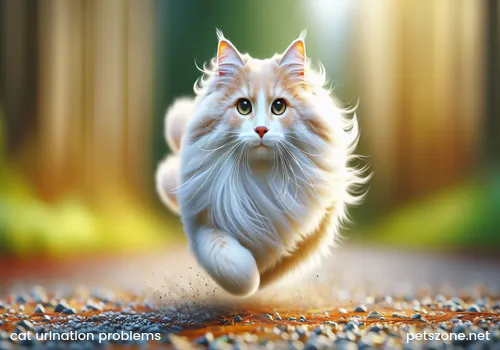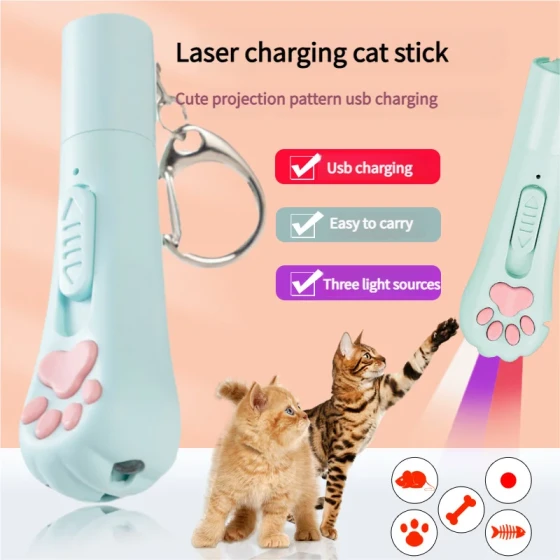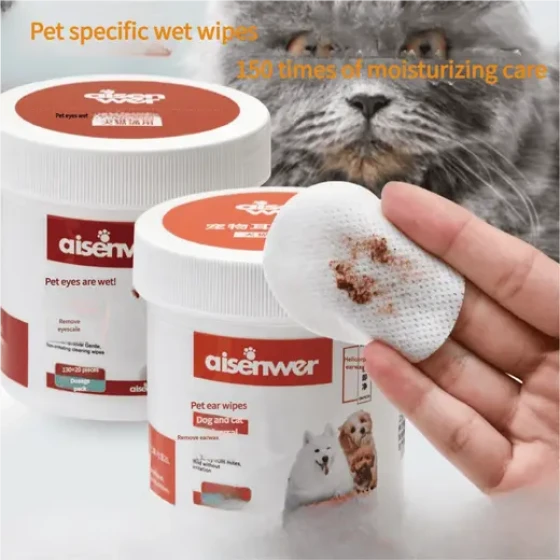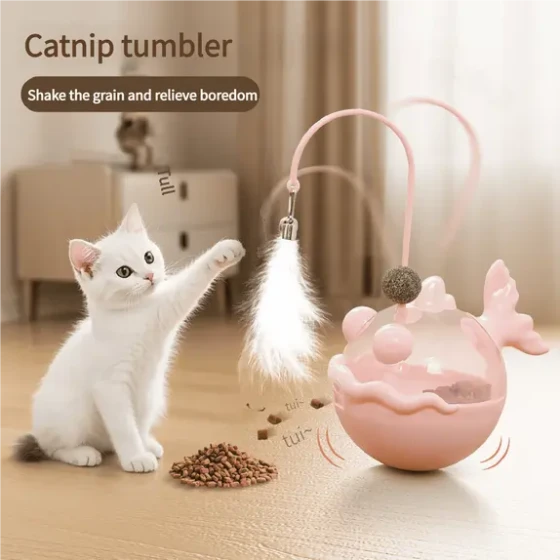What to Do If Your Cat Urinates Everywhere_Solutions and Tips Shared
To be honest, cat urinating everywhere might initially make you angry or frustrated, because no one likes to have mysterious “maps” appear around the house. But behind this often isn’t the cat’s “revenge” or “mischief,” but a string of silent distress signals, or rather, their most primitive way of trying to tell you that their “small world” has problems. Understanding this is the starting point to solve the problem, and a basic quality a responsible cat owner should have.
Remember, when your cat starts eliminating outside the litter box, the most important and critical first step is: take it to the vet.

Don't underestimate this step because it helps you rule out the most direct and often overlooked possibility—physical illness. Many times, inappropriate urination is not a behavioral issue but a direct expression of physical discomfort. Urinary tract infections, bladder stones, kidney problems, diabetes, hyperthyroidism, and even arthritis can cause cats to experience painful urination, increased frequency, difficulty controlling urination, or discomfort entering and exiting the litter box, making them choose other places. Imagine if going to the bathroom became a painful matter, who would willingly go? Especially for male cats, their urinary tract structure makes them more prone to urinary blockage, which is very dangerous and must not be delayed.
Therefore, before considering any behavioral correction, be sure to have a professional veterinarian conduct a comprehensive check, including urinalysis, blood tests, and even imaging tests, to rule out all potential health issues.
If the vet finds your cat is healthy with no physical problems, congratulations, you have ruled out the most complex cause. Next, you need to act like a detective, delving into your cat’s inner world and living environment to dig out the real culprits behind their “crossing the line”—behavioral and environmental factors.
This part often accounts for the majority of "cat urinating everywhere" problems and is where your observation skills and patience as a cat owner are tested the most. Don’t think cat urinating outside the litter box is simply about “not liking the litter box”; it might be just the tip of a systemic problem’s iceberg.
2. Environment and Behavior: An In-depth Exploration of "Bathroom Freedom" and "Emotional Expression"
Cats are famously “particular,” especially regarding their toileting habits. They have their own “cleanliness obsession” and “safety rules.” Any change that touches these rules can trigger a “elimination revolution.”
- Requirements for the litter box: it's more than just a box
- Is the quantity adequate? Multi-cat households should especially note this. A widely verified unwritten rule is: number of litter boxes = number of cats + 1. This isn’t obsessive mathematical behavior but to avoid potential conflicts between cats (like a dominant cat monopolizing the litter box entrance), provide more options, and ensure there is always a clean “spot.” Imagine you have two cats but only one litter box—that's essentially a “public restroom” level of crowding and inconvenience. Especially for lower-ranking or timid cats, going to the toilet may mean facing ambush anytime, so, over time, they naturally look elsewhere.
- Is the location right? The litter box location is as important as Location, Location, Location in real estate. It needs to meet a few basic conditions:
- Quiet and private: Avoid areas near noisy appliances like washing machines, TVs, vacuum cleaners, and away from busy corridors or doorways. Who wants to be startled by loud noise or be watched by people when “doing their business”? The ideal location is a room corner where the cat feels backed up and secure.
- Away from food and water bowls: This is instinctive to cats. They won’t eliminate near their eating and drinking places, just like you wouldn’t put your dining table in the bathroom.
- Clear access route: Especially in multi-cat homes, ensure the path to the litter box is unobstructed, and no other cat “charges a toll” waiting at the door.
- Multiple levels, litter boxes on each floor: If your home is duplex or multi-story, it's best to have at least one litter box per floor, especially for older cats or those with joint issues, so they can find a “nearby bathroom” without climbing stairs.
- The litter box itself: size, type, and height
- Size should be large: Ensure the cat can easily turn around, dig, and cover waste. A common suggestion is that the length should be at least 1.5 times the cat’s body length (excluding the tail). Too-small litter boxes restrict their natural behavior and make them feel cramped and uneasy.
- Open or covered? Most cats prefer an open litter box. Covered boxes might block some odors and litter scatter, but they can make cats feel trapped with limited view (unable to scan the surroundings), and poor air circulation inside can result in stronger odors, which is a big turn-off for scent-sensitive cats. If your cat prefers a covered box, make sure it is large enough and cleaned more frequently.
- Entry height: For kittens, elderly cats, or cats with arthritis, high litter box edges make access difficult or painful. Choosing a low-sided box or placing a small step nearby helps significantly.
- Litter: texture and scent
- Unscented is king: Most cats prefer unscented litter. Human-perceived pleasant fragrances can be pungent or even repulsive to cats with sensitive noses.
- Texture preference: Most cats like fine-grain, soft-textured litter like bentonite clay or fine tofu litter. Rough, sharp-edged litter can make their paws uncomfortable. Especially cats that have undergone declawing (a controversial surgery) are very sensitive to texture and need very soft litter. When changing litter, adopt a gradual method by mixing old and new litter and slowly increasing the new litter ratio to let the cat adjust.
- Cleanliness: This is the most important point. Cats are extremely clean animals. A dirty, smelly litter box is “unusable” in their eyes. Frequent scooping is basic; clean at least once or twice daily, thoroughly replace litter weekly and wash the box (with warm water and unscented soap or a small amount of neutral detergent; avoid ammonia or bleach cleaners as their smell attracts cats to urinate again in the same spot).
- Stress and Anxiety: The invisible “stress bomb”
Cats are sensitive animals and care deeply about changes in their environment and routine. Stress and anxiety are common causes of inappropriate urination.
- Common stressors:
- Environmental changes: Moving house, renovations, new furniture, rearranged furniture layout.
- Family member changes: New pets (especially new cats), new family members (babies, partners, roommates), familiar people or pets leaving.
- Disrupted daily routine: Changed owner work hours, long absences (separation anxiety), irregular feeding times.
- External threats: Seeing new stray or neighbor cats outside the window, construction noise in the home.
- Tense inter-cat relationships: Conflicts, bullying among cats, especially near the litter box, in multi-cat households.
- Signs of stress: Urinating outside the box is just one sign. Others include hiding, loss of appetite, excessive grooming, increased aggression, raised fur, dilated pupils, hissing, etc. Some stressed cats may even develop Feline Idiopathic Cystitis (FIC), a bladder inflammation closely linked to stress, causing painful urination and inappropriate elimination. Although physiological, its root lies in psychological stress.
- How to alleviate stress:
- Provide a sense of security: Give cats plenty of hiding places (cardboard boxes, cat beds, high perches) so they have somewhere to retreat when uneasy.
- Environmental enrichment: Provide scratching posts, toys, cat trees, allowing cats to expend energy and ease emotion.
- Maintain routines: Try to keep feeding, playing, and cleaning on a regular schedule.
- Introduce changes slowly: If environment or household members must change, do so gradually, allowing cats sufficient time to adapt.
- Pheromone products: Diffusers or sprays such as Feliway mimic feline facial pheromones (“happy messages”), helping to ease tension and create a safe, relaxed atmosphere.
- Medication assistance: Under vet guidance, for severe anxiety or stress, anti-anxiety drugs or supplements may be considered.
- Common stressors:
- Marking Behavior vs. Elimination: Is it a protest or just going to the bathroom?
It’s important to understand whether your cat’s inappropriate urination is marking behavior or simple elimination, though sometimes it’s hard to tell.
* Marking behavior (Spraying): Usually involves standing sideways or with tail up and lightly trembling, spraying a small amount of urine onto vertical surfaces (walls, furniture, doors). This is the cat’s way to declare territory, cope with stress, or attract mates (esp. unneutered males). Neutering is one of the most effective ways to reduce marking.
* Elimination behavior (House Soiling): Usually involves squatting on horizontal surfaces (floor, carpet, bed) to release a larger amount of urine or feces. This is often linked to litter box issues or health problems.Of course, a cat can show both behaviors simultaneously or one may cause the other. For example, a urinary infection may make using the litter box painful, so the cat eliminates elsewhere and develops a “surface preference” for the new site; or family changes cause stress triggering marking, meanwhile anxiety may also cause actual elimination problems.
3. Cleaning the Scene: Breaking the “Scent Memory” Chain
No matter why the cat urinates outside the box, thoroughly cleaning the “crime scene” is a key step; otherwise, leftover urine odors will attract the cat back to the same place, creating a vicious cycle.
- Enzymatic Cleaner: Ordinary cleaners or disinfectants cannot completely remove the urate crystals in urine, which continue to emit odor after drying. Enzymatic cleaners use biological enzymes to break down these organic substances to eliminate odor fundamentally. Choose a cleaner specifically for cat urine for better results.
- Cleaning procedure: First use paper towels to absorb as much urine as possible, then soak the stained area thoroughly with enzymatic cleaner, covering beyond the stain because urine may have spread. Let it sit according to product instructions, then air dry naturally. Multiple treatments might be required to fully remove odors.
- Never use ammonia or bleach-based cleaners: Cat urine contains ammonia; using ammonia-based cleaners makes the area smell like a “toilet,” encouraging cats to urinate there again.
4. Behavioral Intervention and Auxiliary Measures: Getting Your Cat "Back on Track"
After excluding health problems and optimizing the litter box environment, if issues persist, further behavioral interventions might be needed.
- Change the "property" of unwanted urination spots: Cats rarely urinate where they eat, drink, or sleep. Place food bowls, water, or their beds and toys on areas where they frequently urinate to make these spots unsuitable for toileting. You can also cover the area with textures cats dislike, such as double-sided tape, aluminum foil, or upside-down carpet mats.
- Place a new litter box near the soiled spot: If the cat strongly prefers a particular wrong spot, try placing a new litter box that fits its preferences there. Once the cat uses it consistently, slowly move the box a few centimeters each day towards the final desired location.
- Positive reinforcement of correct behavior: When you observe the cat using the litter box, immediately give verbal praise, petting, or treats. Help it associate the litter box with positive experiences.
- Do not punish: Never physically punish, scold, or push the cat’s nose into urine. This only increases fear, stress, and anxiety, damages your relationship, worsens the problem, and may cause the cat to eliminate in more hidden places. Cats do not urinate out of malice or revenge and cannot associate punishment with location.
- Professional consultation: If all methods fail or the situation is complex (such as severe conflict in multi-cat homes or extreme stress), consider seeking help from veterinary behaviorists or certified cat behavior consultants. They have professional knowledge and experience to analyze your cat’s specific case and devise personalized solutions.
Final words: Patience, love, and understanding are the ultimate keys to solving the problem
Cat urinating everywhere is a common yet troubling issue; it mirrors possible physical or psychological discomfort in cats. Solving it requires patience, careful observation, and a willingness to understand the logic behind your cat’s behavior. This is not a battle of will between human and cat but a challenging yet affectionate cooperation process. When you successfully help your cat regain "bathroom freedom" and restore their sense of security, you’ll find your relationship with your feline companion becomes closer and more trusting. As the old saying goes, "Raising cats is not easy; cherish them as you go," a shared encouragement.
References (non-cited order):
* Just Cats Clinic article on cat behavioral urination issues
* Dumb Friends League guide on litter box problems
* Cornell University College of Veterinary Medicine article on feline elimination problems
* ASPCA article on cat litter box issues
* Tencent News, QQ News media reports on causes and stress related to cat urination problems
* Veterinary Partner, VCA Animal Hospitals veterinary websites on inappropriate elimination in cats
* The Spruce Pets, PetMD pet websites on cat urination causes and cleaning methods
* Professional cat behavior consultants and related publications
* Cat pheromone products (like Feliway), enzymatic cleaners (like Nature's Miracle, Rocco & Roxie) product information and user feedback





